Raghavan Srinivasan's Blog
October 21, 2022
Jain temple at Ranakpur
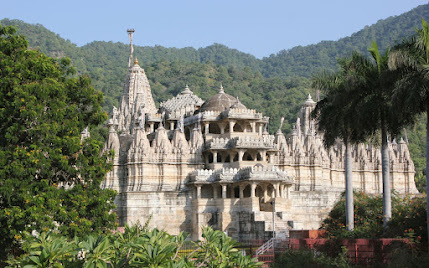
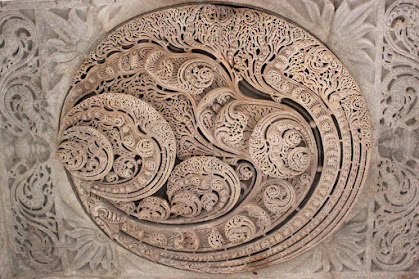
The Jain temple at Ranakpur in Rajasthan honours Adinath, the first Tirthankar. I read about it in Kiran Nagarkar's novel Cuckold and made up my mind to make it the first halt in my next trip to Rajasthan. Here is how he describes it.
'The temple was built during the golden age of architecture in Mewar. .. At the extreme corner of the building are round bulwarks as at any fort except these are much shorter. Ranged across the entire plinth are enclosure walls that are really a series of miniature temples housing subsidiary luminaries from the Jain pantheon. Four beautifully proportioned central gateways interrupt the shrines on all four sides. It is impossible to gauge how stupendously large and complex the temple is until you get to the very heart of the edifice. And yet, that too is a limited and partial view for one has not yet climbed to the first and then the second storey.
Jain saviours in the panels stand or sit, stiff and erect, compellingly directing one's attention to their large, shining, unblinking eyes. The quadruple image of Adinath in the core chamber at the very top is no exception. You may close your eyes but you always know that the Tirthankar's eyes are within you, not outside.
In Hindu temples... the garbha griha, the sanctum sanctorum where the image of the deity resides, is almost always the heart of darkness. It symbolises the impenetrable mystery of divinity. It is the primal womb, a tight and closed blackness, a claustrophobic and intimidating place which only the intermediaries between the deity and the layman, the brahmins, may negotiate. The Jain temple turned the Hindu concept on its head. It brought things out in the open. Instead of the subterranean and the secretive, light and air were the elements of the divine here. The white marble was part of that openness. It had the swirl and speed of milk being poured.
The Ranakpur temple may be dedicated to Adinath. And yet if you ask me, it is a celebration of the Sun god. It's thrust and impulse are light and its goal is enlightenment. It is unlike any temple I know'.
#indianarchitecture#jaintemples #indiantemples
February 2, 2022
Author Interview
Author Raghavan Srinivasan: A massive amount of information is undoubtedly available on Rajaraja Chola, the greatest emperor that South India has seen, from stone inscriptions, copper plates, coins, manuscripts and architectural findings, though historians have noted the disappearance of several literary works belonging to his period with gloom.
But the challenge was to present the story of Rajaraja in an interesting way, particularly to the millennials, without in any way undermining the authenticity and veracity of the narrative. This is easier said than done. Even well-established historians differ violently, in the academic sense, on their interpretation of historical facts surrounding his imperial rule. Rajaraja’s regime has been variously categorized as ‘tyrannical’ at one end to nothing less than a ‘golden age’ at the other and more often as a chronicle of ‘plunder and piety’.
TBE: What first drew you to the Chola dynasty and to the study of Rajaraja Chola? In your opinion, what makes his story relevant for our times?
Author Raghavan Srinivasan: Many novels and books have been written on Rajaraja, or Arulmozhivarman, as he was called before his ascension to the Chola throne. Films and TV serials have been made on a modest scale. In the 1950s, novelist Kalki Krishnamurthy published Ponniyin Selvan as a weekly series in the Tamil magazine Kalki.Even today, the novel has a cult following and a massive fan base among readers across several generations.
A popular film on Rajaraja Cholan with thespian actor Sivaji Ganesan in the lead role was released in 1973 and received critical acclaim. In 2010, a spectacular celebration was organized to celebrate the 1000th year of the Brihadeeswara temple, built by Rajaraja in Thanjavur. A film is under making by director Mani Ratnam based on Kalki’s magnum opus. Several history books, particularly Nilakanta Sastri’s The Colas, a landmark volume on the Chola dynasty, and Champakalakshmi’s Trade, Ideology and Urbanisation provide a good narrative on the reign of the emperor, as a part of a larger setting.
Yet they are not enough, considering the colossal changes that took place in Thamizhagam during the 25 years of his reign from 985 CE and beyond. Till today, there is no publication in English, to my knowledge, that comprehensively covers the regime of this illustrious empire builder, almost subscribing to the anguish of the people of the South that their history has been given second place.
There are many who dismiss history as irrelevant in today’s changing world. For them, the society that existed 1000 years back and events connected to it are feudal, backward and anachronistic. But a civilisation which forgets its history has nothing to build on for its future. Negating one’s heritage opens the door to subjugation by some other ‘superior culture’ of an ‘advanced’ civilisation. This is what happened during the colonial conquests when a section of the freedom movement failed to draw inspiration from our rich heritage and instead succumbed to western thought.
Therefore, the story of Rajaraja is very relevant today. There are huge expectations among the youth today to learn more about our rich heritage from authentic sources. I hope this book encourages them on their illuminating journey.
TBE: Is there more pressure when you’re writing non-fiction history? How is the research process different from historical fiction?
Raghavan Srinivasan: Both fiction and non-fiction pose different challenges. Historical fiction gives the author more flexibility in dealing with a particular historical event or a historical personality. But academics and professionals do not take historical fiction seriously.
Non-fiction, on the other hand, requires much more research and a rigorous presentation of facts. Historical non-fiction has to be strictly based on evidence such as inscriptions, copper plates, coins, archeological findings, etc. It has a longer shelf-life than fiction.
TBE: What challenges did you encounter while researching and writing your book? What surprised you most in your research?
Raghavan Srinivasan: There is very little written record of his personality. No eyewitness has rendered to Rajaraja the service which Nuniz and Paes did to Krishna Deva Raya. What was very surprising was that there is not even a well-attested statue or a painting of this king that has come down to us. Even his burial place has not been conclusively identified.
All that we know of his reign, however, and that is not little, attests his potent personality and the firm grasp of his intellect which allowed nothing to escape its vigilance and applied itself with as much vigor to the minutest details as to the sublimest ambitions of statecraft.
TBE: Winning the war is easier than securing the peace. How did Rajaraja secure his empire and leave behind a stupendous legacy?
Raghavan Srinivasan: Historians have acknowledged that military might may not have been the only factor for the expansion of the Chola overlordship under Rajaraja and Rajendra from their core domain in the Kaveri basin to the entire Tamil plain and its adjacent upland. It was not achieved nor was it maintained by military means alone. Exemplary moral behavior may have also contributed to this. Chola kings… were exemplars of medieval South Indian kingship and models of appropriate rulership for chiefs of the macro region; it was less the might of the Chola rulers than it was their moral appropriateness that provided the basis of Chola rule over the Coramandel plain.
In his reign, powerful productive forces were unleashed to take the empire to new heights in art, architecture, religion, literature, administration, statecraft, military and naval might.
TBE: How has the legacy of Rajaraja Chola shaped India into the country it is today?
Raghavan Srinivasan: It will not be an overstatement to say that Rajaraja Chola left a stupendous legacy behind him, which has not lost its sheen even after a thousand years. His reign holds a vital place in the history of Thamizhagam as well as the rest of India. His thirty long years of rule constituted the formative period of the Chola Empire.
Victory in wars can get you on the throne, but they are not enough to keep you there. It is beyond debate that ‘in the organization of the civil service and the army, in art and architecture, in religion and literature, we see at work powerful forces newly liberated by the progressive imperialism of the time’. The productive forces that emerged, the nagarams which flourished, the in-land and overseas trade networks that were established, the high standards of art, literature and craft that were attained, makes him an extremely popular emperor. Women of the upper class and saints enjoyed honour and privileges in the empire, as we had seen in many instances.
The state did not play on the religious divisions among the people. The thousand-year-old administrative system and the principle of self-administration that he encouraged are relevant even today, of course after rendering them modern. That altogether would be the right approach to take to the great stories, legends and achievements of this great empire and its accomplished architect – the emperor and the entire talent he commanded from every corner of the empire.
TBE: What do you think we can learn today from Rajaraja Chola who ruled in India more than 1000 years ago? What could Rajaraja Chola tell the current administration?
Author Raghavan Srinivasan: The heights achieved in architecture, sculpture, art and literature during the times of the Chola empire remain unparalleled even today. The Uttaramerur inscriptions which describe the democratic process 1000 years back are still considered very relevant in today’s society where caste and income inequalities have widened and democratic aspirations of the people unfulfilled.
TBE: Which history books or authors have inspired you?
Raghavan Srinivasan: Nilakanta Sastri, A.L. Basham, Champakalakshmi, Romila Thapar, Alex Rutherford and Conn Iggulden are history writers who have inspired me.
TBE: How was your publishing experience with Leadstart?
Raghavan Srinivasan: Pretty good. They guided me in many aspects of publishing and popularizing the book.
TBE: Is there anything you are currently working on that may intrigue the interest of your readers?
Raghavan Srinivasan: I am now working on a historical, biographical fiction, which I plan to publish in two parts. The story is located in twentieth century Madras and the political milieu of Madras Province.Rajaraja Chola: Interplay Between an Imperial Regime and Productive Forces of Society
September 27, 2021
Rajaraja Chola - A historical non-fiction
With the accession of Rajaraja Chola, the land of Tamils entered upon centuries of grandeur.
He has left a stupendous legacy behind him, which has not lost its sheen even after a thousand years.
I have tried to present the social and economic underpinnings of this regime.
Hope it is interesting reading.
Rajaraja Chola: Interplay Between an Imperial Regime and Productive Forces of Society https://www.amazon.in/.../ref=cm_sw_r......
September 22, 2021
Rajaraja Chola: Interplay Between an Imperial Regime and Productive Forces of Society

With the accession of Rajaraja Chola, the land of Tamils entered upon centuries of grandeur.
He has left a stupendous legacy behind him, which has not lost its sheen even after a thousand years. I have tried to present the social and economic underpinnings of this regime.
Hope it is interesting reading.
Rajaraja Chola: Interplay Between an Imperial Regime and Productive Forces of Society
https://www.amazon.in/Essay-Letter-Special-Current-Event/dp/9354581145[image error][image error]22Indra Srinivasan, Balasubramanian Ananthanarayan and 20 others
September 7, 2021
Pallava architecture

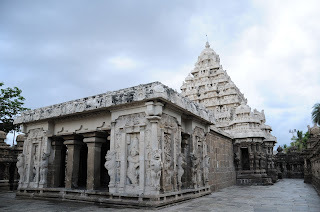

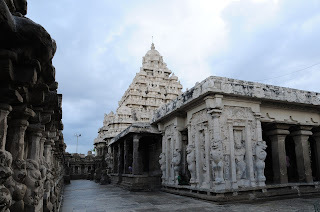
While researching for my book on Rajaraja Chozha, being published by @Leadstart, I did some comparison of the architecture of stone temples between the Pallava and Chozha periods from narratives available in a few excellent publications on the subject. This was the time when architecture, art and painting reached a zenith. Towns and cities were mushrooming. New productive forces were being unleashed. The imagination of the craftsmen was taking full flight.
Early temples were structures of brick and mortar, unable to withstand the ravages of nature. When the Pallavas in the time of Mahendravarman built rock-cut temples, that signified a big advancement. Within another two centuries, the Pallavas perfected the art of erecting structural temples of stone.
The Kailasanathar temple at Kanchipuram, built in the late 7th century, is believed to be the first structural temple in stone built in South India. Narasimhavarman II (Rajasimha) started the construction and his son, Mahendravarman III, completed the front façade and the gopuram.
The temple became the trend setter for other similar stone temples in South India. It is believed that Raja Raja Chozha I visited the temple and drew inspiration to build the Brihadeeswara Temple, three centuries later.
The pillars of the mandapam of the Kailasanthar temple have the repetitive features of mythical lion mounts. The garbhagrha of the Kailasanathar temple is a composite structure, with a central cella facing east to west to which are attached smaller shrines built onto its walls of the three free sides and the four corners of the main shrine.
In contrast, in the early Chozha temples, the sub-shrines are detached from the main sanctum, and arranged as separate shrines around it in the courtyard, facing the main shrine and its axis, each dedicated to a subsidiary deity.
Photo credits: My friend and class mate, GV Balasubramanian, Engineer by Qualification, Banker by Profession, Photographer by Passion!
Rajaraja Chola: Interplay Between an Imperial Regime and Productive Forces of Society
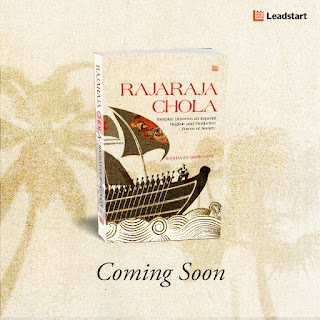
It took a long time. But it was worth it. To be released soon.
It recreates the history of a South Indian king and his imperial empire. Hope it appeals to academia and the wider public audience!#rajarajacholan #leadstart #southindianhistory #asianhistory #medievalhistory #biography #yugantar #yugantarbharatavarsha #bookstagramindia #cholasculpture #cholacoins #medievalindianhistory #cholahistory #leadstartpublishing
https://www.instagram.com/p/CTgiNnWLj9r/?utm_medium=share_sheet
April 14, 2021
Author Interview - Raghavan Srinivasan - Author of Yugantar
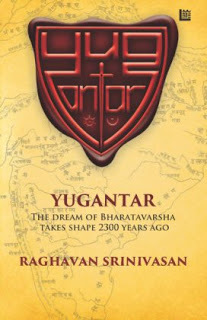
https://www.bookishelf.com/raghavan-s...
TBE: Tell us about your book, can you share with us something about the book that isn’t in the blurb?Raghavan Srinivasan: Yugantar is not just a historical fiction. It deals with several philosophical trends popular at the time of the rise of the Mauryan Empire in the north, north-west and south of the subcontinent. It also weaves in an assessment of the political, scientific and technological advancements being made at that time.
TBE: What brought about the idea for Yugantar and why did you want to write it?
Raghavan Srinivasan: The idea is that though the Indian subcontinent was divided into republics and kingdoms, a fabric of popularly accepted philosophies and cultures has always held it together. Whenever fanaticism and obscurantism raised their head, the subcontinent became vulnerable to internal dissensions and external aggression. Material and spiritual deterioration set in. I took up writing this novel because today the subcontinent is witnessing such a sandhi, a block to its progress. The past can provide clues to solve the current crisis.
TBE: According to you What is important in shaping the society of the world today or in the future?
Raghavan Srinivasan: A society has to settle scores with its past conscience in order to remain relevant today and in the future. Which means that it should respect the rich heritage of the past, but not just live in the past. It has to identify the best vignettes of its past and render them modern. Moreover, this has to be led by the productive forces of society who are shaping today’s world.
TBE: Do you think, for both children and adults, understanding the history associated with one’s culture is important? Why?
Raghavan Srinivasan: A sense of belonging comes only when we have understood our history, culture and politics. Ignorance of our history and culture would lead us to believe that our culture is backward and some other culture is more advanced.
TBE: Does Indian history, if interpreted without any bias, teach people to be more accepting of other cultures?
Raghavan Srinivasan: The history of India is a history of assimilating different philosophies and cultures, encouraging debates, and not only tolerating but respecting different points of view. So, if Indian history is presented factually and fully, then it will be possible for old and young generations to come to their own conclusions and appreciate diverse schools of thought and socio-cultural aspects.
TBE: What was your writing process for this book? And How long did it take you to write this book?
Raghavan Srinivasan: Over the years I had been reading books on the period. But when I started writing it required a lot of effort to understand how people lived and thought during that period. I spent a lot of time to understand the context of that period, 2300 years ago, before I attempted the chapterisation. It took about 4 months to arrive at a decent manuscript.
TBE: During your journey from the idea of this book to the publication, what was the most difficult thing you faced? Is there anything you find particularly challenging in your writing?
Raghavan Srinivasan: What was most challenging was to connect socio-political, philosophical and cultural trends across the Indian subcontinent and get under the skin of people living in that period. While history books, fiction and non-fiction, deal with a particular geographical location or an empire, this novel required an understanding of contemporary processes across a huge cultural, political and geographical landscape. The novel is layered into several sub-stories of characters belonging to totally different regions and sub-cultures. It was challenging to keep alternating while sticking to an overall plot.
TBE: What do you hope your readers take away from this book?
Raghavan Srinivasan: I hope the readers would appreciate the concept and entity called bharatavarsha with all its diversities. When writing the novel, I have also made some far-reaching historical interpretations and deductions about bharatavarsha, which I hope the readers would appreciate.
TBE: Do you read much and if so, which are your favorite books and authors?
Raghavan Srinivasan: I read a lot, sometimes 3 or 4 books at the same time to relieve any monotony. Reading across genres provides new perspectives. My favourite books are historical fiction and non-fiction, philosophy, mystery, mythology, short stories and adventure. I like Anand Neelakantan, Amitav Ghosh, William Dalrymple, George Martin, Shashi Tharoor, Vikram Chandra, Kalki Krishnamurthy, etc and, of course, the western classical authors.
TBE: What do you like to do when you’re not writing?
Raghavan Srinivasan: I am a social activist and a political commentator. I participate in actions and debates related to human rights, democracy, etc. Besides I like to travel to places of historical and cultural interest. I listen to music too and play a bit of keyboard.
TBE: What was one of the most surprising things you learned during creation of your book?
Raghavan Srinivasan: That I could write a story located in a society I have never seen. Also, that I could appreciate the different writing styles of authors and genres. Writing the novel never weighed on me as a burden or a responsibility to be completed. I really enjoyed the work like a sculptor slowly seeing his creation taking shape.
TBE: Is there anything you are currently working on that may intrigue the interest of your readers?
Raghavan Srinivasan: I have completed a manuscript of a historical non-fiction on Rajaraja Chola, the emperor of South India, who laid the foundations of the longest Indian empire. It would be the first comprehensive book in English on the emperor and the social, political milieu at that time. The treatment is not academic and the book would provide fresh and interesting perspectives on life in those times.
February 24, 2021
M���cchakatika (������������������������������), The Little Clay Cart ��� A Sankrit drama par excellence
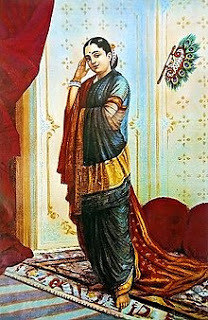
For reconstructing life in Ujjayini in my novel Yugantar, I relied on M���cchakatika (������������������������������), The Little Clay Cart. It is a ten-act Sanskrit drama created by ����draka, a playwright of the 5th century CE. The play is set in the ancient city of Ujjayini during the reign of the King P��laka, near the end of the Pradyota dynasty that made up the first quarter of the fifth century BCE. The central story is that of a noble but impoverished young Brahmin, C��rudatta, who falls in love with a wealthy courtesan, Vasantasen��. Despite their mutual affection, however, the couple's lives and love are threatened when a lecherous courtier, Samsth��naka, begins to aggressively harass Vasantasen��.
The drama is rife with romance, comedy, intrigue and a political subplot around the overthrow of the city's despotic ruler by a shepherd. The play is notable for its focus on a fictional scenario rather than on a classical tale or legend. M���cchaka���ika also swerves away from the traditional approach that dramas should focus on the lives of the nobility. It gives importance to many peasant characters who speak a wide range of Prakrit dialects, the language of the people.
The work played a significant role in generating interest in Indian theatre among European audiences following several successful nineteenth century translations and stage productions.
Unlike other classical plays in Sanskrit, the play does not borrow ideas from epics or mythology. The characters of ����draka are drawn from the mundane world. It is peopled with gamblers, courtesans, thieves, and so on. The protagonist of the play, C��rudatta, does not belong to the noble class or royal lineage. Though Vasantasen�� is a courtesan, her exemplary attitude and dignified behavior impress the audience. The nobility of the characters does not stem from their social conditioning but from their virtues and behaviour.
I am giving a small extract below from Ryder���s translation:
Maitreya. [Enters and looks about.] Well! What a beautiful orchard! There are any number of trees planted here, and they are covered with the most wonderful flowers. Silken swings are hung under the thick-set trees, just big enough for a girl to sit in. The golden jasmine, the sheph��lik��, the white jasmine, the jessamine, the navamallik��, the amaranth, the spring creeper, and all the other flowers have fallen of themselves, and really, it makes Indra's heaven look dingy. [He looks in another direction.] And the pond here looks like the morning twilight, for the lilies and red lotuses are as splendid as the rising sun. And again:
The ashoka-tree, whose twigs so merry
And crimson flowers have just appeared,
Seems like a battling mercenary,
With clotting crimson gore besmeared.
(Translated by Arthur William Ryder)
(Story adapted from Wikipedia)
Mṛcchakatika (मृच्छकटिका), The Little Clay Cart – A Sankrit drama par excellence

For reconstructing life in Ujjayini in my novel Yugantar, I relied on Mṛcchakatika (मृच्छकटिका), The Little Clay Cart. It is a ten-act Sanskrit drama created by Śūdraka, a playwright of the 5th century CE. The play is set in the ancient city of Ujjayini during the reign of the King Pālaka, near the end of the Pradyota dynasty that made up the first quarter of the fifth century BCE. The central story is that of a noble but impoverished young Brahmin, Cārudatta, who falls in love with a wealthy courtesan, Vasantasenā. Despite their mutual affection, however, the couple's lives and love are threatened when a lecherous courtier, Samsthānaka, begins to aggressively harass Vasantasenā.
The drama is rife with romance, comedy, intrigue and a political subplot around the overthrow of the city's despotic ruler by a shepherd. The play is notable for its focus on a fictional scenario rather than on a classical tale or legend. Mṛcchakaṭika also swerves away from the traditional approach that dramas should focus on the lives of the nobility. It gives importance to many peasant characters who speak a wide range of Prakrit dialects, the language of the people.
The work played a significant role in generating interest in Indian theatre among European audiences following several successful nineteenth century translations and stage productions.
Unlike other classical plays in Sanskrit, the play does not borrow ideas from epics or mythology. The characters of Śūdraka are drawn from the mundane world. It is peopled with gamblers, courtesans, thieves, and so on. The protagonist of the play, Cārudatta, does not belong to the noble class or royal lineage. Though Vasantasenā is a courtesan, her exemplary attitude and dignified behavior impress the audience. The nobility of the characters does not stem from their social conditioning but from their virtues and behaviour.
I am giving a small extract below from Ryder’s translation:
Maitreya. [Enters and looks about.] Well! What a beautiful orchard! There are any number of trees planted here, and they are covered with the most wonderful flowers. Silken swings are hung under the thick-set trees, just big enough for a girl to sit in. The golden jasmine, the shephālikā, the white jasmine, the jessamine, the navamallikā, the amaranth, the spring creeper, and all the other flowers have fallen of themselves, and really, it makes Indra's heaven look dingy. [He looks in another direction.] And the pond here looks like the morning twilight, for the lilies and red lotuses are as splendid as the rising sun. And again:
The ashoka-tree, whose twigs so merry
And crimson flowers have just appeared,
Seems like a battling mercenary,
With clotting crimson gore besmeared.
(Translated by Arthur William Ryder)
(Story adapted from Wikipedia)
Sushruta Samhita ��� An awesome 2500 year old Sanskrit text on medicine and surgery!
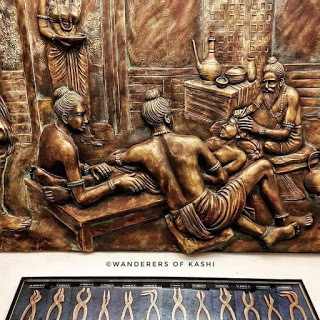
The Sushruta Samhita is among the most important ancient medical treatises. It is one of the foundational texts of the medical tradition in India, alongside the Charaka-Sa���hit��, the Bhe���a-Sa���hit��, and the medical portions of the Bower Manuscript.
The Sushruta Samhita was composed after Charaka Samhita, and except for some topics and their emphasis, both discuss many similar subjects such as General Principles, Pathology, Diagnosis, Anatomy, Sensorial Prognosis, Therapeutics, Pharmaceutics and Toxicology.
The Sushruta and Charaka texts differ in one major aspect, with Sushruta Samhita providing the foundation of surgery, while Charaka Samhita being primarily a foundation of medicine.
The Sushruta Samhita, in its extant form, is divided into 186 chapters and contains descriptions of 1,120 illnesses, 700 medicinal plants, 64 preparations from mineral sources and 57 preparations based on animal sources.
The Sushruta-Sa���hit�� is divided into two parts: the first five chapters, which are considered to be the oldest part of the text, and the "Later Section" (Skt. Uttaratantra) that was added by the author Nagarjuna. The content of these chapters is diverse, some topics are covered in multiple chapters in different books
The Sushruta Samhita is best known for its approach and discussions of surgery. It was one of the first in human history to suggest that a student of surgery should learn about human body and its organs by dissecting a dead body. A student should practice, states the text, on objects resembling the diseased or body part. Incision studies, for example, are recommended on Pushpaphala (squash, Cucurbita maxima), Alavu (bottle gourd, Lagenaria vulgaris), Trapusha (cucumber, Cucumis pubescens), leather bags filled with fluids and bladders of dead animals.
The ancient text describes haemorrhoidectomy, amputations, plastic, rhinoplastic, ophthalmic, lithotomic and obstetrical procedures.
The treatise mentions various methods including sliding graft, rotation graft and pedicle graft. Reconstruction of a nose (rhinoplasty) which has been cut off, using a flap of skin from the cheek is also described. Labioplasty too has received attention in the samahita.
The Sushruta Samhita, along with the Sanskrit medicine-related classics Atharvaveda and Charaka Samhita, together describe more than 700 medicinal herbs. The description includes their taste, appearance and digestive effects to safety, efficacy, dosage and benefits.
A number of Sushruta's contributions have been discussed in modern literature. Some of these include Hritshoola (heart pain), circulation of vital body fluids (such as blood (rakta dhatu) and lymph (rasa dhatu), Madhumeha, obesity, and hypertension. The first mention of leprosy is described in Sushruta Samhita. The text discusses kidney stones and its surgical removal.



